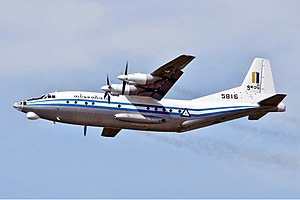Shaanxi Y-8F-600
| Y-8 | |
|---|---|
 |
|
| Y-8 of the Myanmar Air Force | |
| Role | Transport aircraft |
| Manufacturer | Shaanxi Aircraft Corporation |
| First flight | 25 December 1974 |
| Status | In service |
| Primary users |
PLA Air Force Pakistan Air Force |
| Produced | 1981–present |
| Developed from | Antonov An-12 |
| Variants | Shaanxi Y-9 |
The Shaanxi Y-8 or Yunshuji-8 (Chinese: 运-8) aircraft is a medium size medium range transport aircraft produced by Shaanxi Aircraft Corporation in China, based on the Soviet Antonov An-12. It has become one of China's most popular military and civilian transport/cargo aircraft, with many variants produced and exported. Although the An-12 is no longer made in Ukraine, the Chinese Y-8 continues to be upgraded and produced. An estimated 169 Y-8 aircraft had been built by 2010.
In the 1960s, China purchased several An-12 aircraft from the Soviet Union, along with license to assemble the aircraft locally. However, due to the Sino-Soviet split, the Soviet Union withdrew its technical assistance. The Xi'an Aircraft Company and Xi'an Aircraft Design Institute worked to reverse engineer the An-12 for local production.
Design of the aircraft was completed by February 1972. Major features of the Y-8 included a glazed nose and tail turret derived from that of the H-6 bomber, a roller-type palletized-cargo-handling device instead of the overhead conveyor, and a gaseous oxygen system as opposed to a liquid oxygen system. The original Y-8 inherited the An-12’s twin 23mm cannon tail turret, but this was removed on subsequent variants.
The Y-8 equipped with four turboprop engines mounted under the leading edges of non-swept wings. The wings are attached high on the fuselage, and the tricycle landing gear is equipped with low pressure tires. The earliest versions used for the transportation of freight or troops had two side-hinged, inward-opening doors, while later variants used a rearward-facing ramp to facilitate loading and unloading of the payload. Some specialized versions omit the cargo ramp entirely.
The Y-8 is capable of carrying troops, dropping supplies, parachute drops, and functioning as an air ambulance. It also can be used for commercial uses as a freighter. It is capable of hauling 20 tons of cargo, approximately 96 soldiers, or about 82 paratroopers in the cargo compartment which is 13.5 metres long, 3 metres wide and 2.4 metres high. It can also carry 60 severely wounded soldiers with their stretchers, 20 slightly injured soldiers and 3 medical attendants. Many variants for specialized roles have been built, but information on them can be vague or difficult to obtain due to the secretive nature of the Chinese military.
...
Wikipedia
